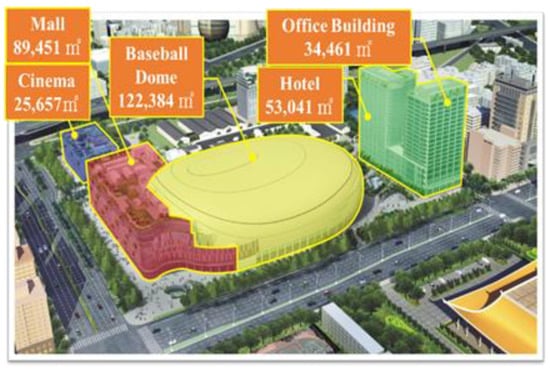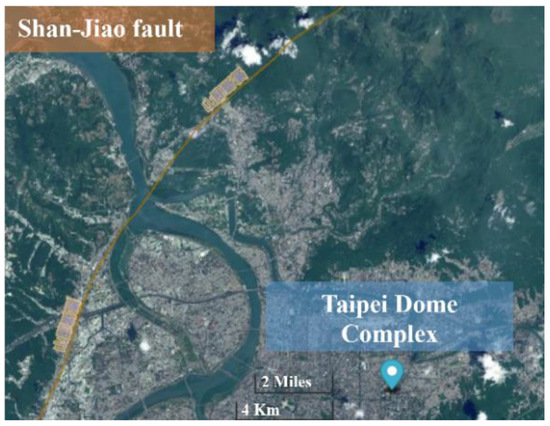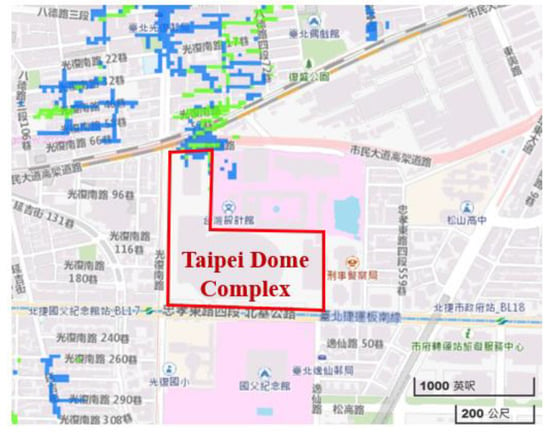Abstract
The Taipei Dome Complex is located in Taipei, Taiwan. It is a composite park with a multi-functional dome and incorporates a shopping mall, restaurants, cinemas, and an office building. In 2017, Taipei, Taiwan hosted the Universiade, and thousands of people protested. Smoke bombs were thrown, and the police were attacked. Due to its location in the “Circum-Pacific seismic belt” and the fact it is affected by the subtropical monsoon climate, Taiwan suffers frequent natural disasters. We aim to define the security risk factors for the Taipei Dome Complex by assessing flood simulation from the National Science and Technology Center for Disaster Reduction, earthquake simulation of the Taiwan Earthquake Loss Estimation System (TELES), and a case study of a terrorist attack. We propose 24 risk factors from five major perspectives: equipment safety, traffic accidents, human resources, security management, and disaster events.
1. Introduction
Because of the spread of terrorism, urban facilities have become the target of terrorist attacks, including transport stations, airports, landmarks of the cities, theaters, critical infrastructures in stadiums, arenas, and domes that hold major sporting events and concerts. On 22 May 2017, at 22:33 British Summer Time, there were explosions at the Manchester Arena where singer Ariana Grande Butera was holding a concert. The nail bombs caused 23 deaths (including that of the attacker) and 119 injuries [1]. It was a terrorist attack by a lone male suicide bomber [2]. After investigation, it was determined that the explosive charges were detonated using a remote-control device and were more likely carried into the venue by being packed in a backpack than in a vest [3]. On 21 August 2017, Taipei, Taiwan hosted the Summer Universiade. Thousands of people protested, a man attacked the police, and several people threw smoke bombs at the venue of the opening ceremony. The accidents prevented athletes from entering the arena on time [4].
The Taipei Dome Complex, the research object of this study, is located in Xinyi District, Taipei City, Taiwan. It is a composite park. The main body is a multi-functional dome, and the other also has constructions such as a shopping mall, restaurant, cinema, and office buildings (Figure 1). The crowd capability of the dome is 59,833 [5], which is approximately double that of the Taipei Arena (currently the largest arena in Taiwan). If an incident like the Manchester Arena terrorist attack occurs in the Taipei Dome Complex, the consequences will be disastrous. Therefore, this study is being carried out to determine the risk factors for disasters and safety events for the Taipei Dome Complex and provides security recommendations for large events.

Figure 1.
Distribution of venues of Taipei Dome Complex.
2. Literature Review
2.1. Potential Disaster Analysis
The TAIPEI Dome Complex is located in the Xinyi District, Taipei City, Taiwan. We used the disaster-causing analysis template proposed by the Federal Emergency Management Agency (FEMA) to analyze potential disasters in the complex, focusing on fire, flood, earthquake, and terrorist attacks, as shown in Table 1. In terms of earthquakes, Taiwan is in the seismically active area of the “Circum-Pacific seismic belt” and the Shanjiao fault is near the Taipei Dome Complex [6] (Figure 2), meaning that the probability of their occurrence is “possible”. According to the simulation results of the Taiwan Earthquake Loss Estimation System (TELES) [7] (Table 2), the number of collapsed houses in the Xinyi District would be 341 (accounting for 2.77% of the entire Taipei City) and the number of resuscitation injuries and deaths would be 66 (accounting for 2.89% of the entire Taipei City), and so the potential impact of an earthquake is “limited”. In the Taipei Dome Complex, compared with other buildings, the seismic performance of the baseball dome is the best. Due to the subtropical monsoon climate, the occurrence probability of flooding is “very likely”. The occurrence is predicted through torrential rain warnings or typhoon tracking, and disaster losses can be reduced through mitigation and remediation works, and so the potential impact is “negligible”. According to the flood simulation of the National Science and Technology Center for Disaster Reduction (NCDR) [6], if the rainfall is more than 130 mm/h, roads in the park will be flooded for 1–3 days (blue patterns showing 0.0–0.3 m flooding and green patterns showing 0.3–1.0 m flooding), as shown in Figure 3. The dome has the best fire performance. If there is a fire in the cinema, shopping mall, or office building, disaster relief assistance will be needed. Based on the political situation between Taiwan and China and the video “No Respite”, which named Taiwan as a member of the global anti-ISIS and was released by the Islamic State of Iraq and al-Sham (ISIS) terrorist organization on 25 November 2015, the occurrence probability of a terrorist attack in Taiwan is “perhaps”. If the terrorist attack happens, in addition to requiring large amounts of emergency medical resources, it could also create international tensions.

Table 1.
Disaster-causing natural disasters on the Taipei Dome Complex.

Figure 2.
Adjacent fault distribution.

Table 2.
Earthquake simulation of Taipei City.

Figure 3.
Taipei city flood simulation 130 mm/h.
2.2. Potential Disaster Analysis
The case of explosions is explored in Manchester Arena, 2017. For disaster relief, human resource deployment for emergency response work is important. The police, emergency services, and ambulance staff entered the building soon after the blast [8]. Conversely, Greater Manchester Fire and Rescue Service crews attended the arena more than two hours and 15 min after the first 999 calls [9], and only three North West Ambulance Service (NWAS) paramedics went into the foyer and triaged and assessed patients [10]. The emergency services showed poor communication across departments and not shared communication channel was established between emergency services [11].
Medical evacuation measures were inadequate. Police officers decided which patients to take out first, but NWAS lost control of the decision on when to bring patients out. Thus, casualties did not arrive at the hospital [10]. After the rescue operation, expert pointed out that the wounds taken out of the bomb scene were unsafe and unnecessary. More specialist paramedics from the response team could have been sent directly to the bomb scene [10].
Developing and implementing a security plan is important. The Pennsylvania-based company that manages the Manchester Arena described that backpacks were not allowed, and drinks were taken away from people. People had to go through strict security to enter the arena [10]. However, the audience said that there were no security measures as people entered the arena—no wanding, no scanning, and insufficient purse and bag checks [12]. If the metal detector had worked, the explosion might not have happened.
For crime scene handling, crowd evacuation guidance is necessary. A wide area around the venue was quickly cordoned off [13] and a bomb disposal team arrived on the scene [1]. Manchester Victoria station near the arena was evacuated and trains were canceled [2]. Taxis swarmed the area to help take people away [13]. Near the end of disaster relief, the emergency placement of victims was necessary. Shops and takeaways around the arena appeared to be handing out drinks [13]. Hotels opened their doors to concertgoers trapped inside the police cordon, providing them with drinks and phone chargers to enable them to contact family members. Residents also offered stranded concertgoers places to stay in their homes [1].
2.3. Related Articles
For advanced stadium security systems, Wan et al. (2021) proposed the AI-CPS model that can predict anomaly behavior in cyber networks [14]. Facing unconventional emergencies, Ni et al. (2020) created a decision-making repository that contained existing emergency response plans (ERPs) that include many emergency response experiences. Considering the semantic relevance and the scenario consistency of ERP segments, applicable sections form new ERPs rapidly [15]. To maximize the benefits of human resources, Granberg et al. (2020) considered training and equipping human resources from other public service sectors to act as first responders to reduce first response times at a low cost [16]. In order to autonomously deploy and provide communication services in disaster sites, Sanchez-Garcia et al. (2019) proposed an algorithm based on the well-known particle swarm optimization algorithm applied in UAV networks to discover the scenario victims faster [17]. In terms of achieving an efficient prehospital emergency response, the collaborative utilization of regional emergency medical services improves the surge capacity in the field and the practices in field triage and transport capacity, and a transfer strategy can be used in mass burn casualty incidents [18].
3. Establishment of Taipei Dome Complex Disaster Risk Factors
We explore risk factors for disasters and safety events through the analysis of potential disasters, relevant paper references, and cases of terrorist attacks in the arena. The key factors affecting the security of the Taipei Dome Complex are summarized into five aspects: equipment safety, traffic accidents, human resources, security management, and disaster event. The security risk factor structure is shown in Figure 4. Equipment safety includes insufficient fire facilities, incomplete barrier-free facilities, poorly maintained machinery, insufficient surveillance facilities, and insufficient cyber security. Traffic accident includes MRT emergencies, bus emergencies, intercity bus emergencies, and tour bus emergencies tha5t affect the crowd in the complex. Human resources includes insufficient firefighting, insufficient police, insufficient security officer, insufficient medical personnel, and insufficient staff member. The security management includes shortcomings in a moving line, shortcomings in evacuation guidance, unclear escape or fire facilities signage, lack of situational exercise, and lack of staff training. The disaster event includes earthquake, fire terrorist attack, and demonstration/protest event.

Figure 4.
Taipei Dome Complex security risk factor structure.
4. Conclusions and Recommendation
Large sports venues like domes, arenas, and stadiums are public leisure and entertainment spaces. The safety issue must be taken seriously. Taking the Taipei Dome Complex as the research target, key factors affecting the security of the complex are summarized into five aspects: equipment safety, traffic accidents, human resources, security management, and disaster event. In the Taipei Dome Complex, among the baseball dome, shopping mall, restaurant, cinema, and office building, the baseball dome has the best seismic performance and fire performance. To respond to disaster events, emergency response plans must be established, and educational training and situational exercises must be adequate. For terrorist attack prevention, organizers should takes the following measures: tour buses and large transport vehicles must not be allowed to enter the park from two hours before activities start until one hour after activities end to avoid collisions with the crowd. X-ray machines must be installed at every entrance to the dome to detect dangerous goods. From audience entry until the event starts, these should be regularly monitored in the computer room. Disabled toilets, parking lots, and other places are difficult to observe. In terms of preventing suspicious persons from entering the regulated area, it is better to improve identification measures for staff. In Taiwan, no law specifies a hospital specifically responsible for receiving victims of terrorist attacks. The government should develop policies for emergency medical care.
Author Contributions
Conceptualization, C.-J.H.; methodology, C.-J.H.; software, T.-Y.C.; validation, C.-J.H. and T.-Y.C.; formal analysis, T.-Y.C.; investigation, C.-J.H.; resources, C.-J.H.; data curation, T.-Y.C.; writing—original draft preparation, T.-Y.C.; writing—review and editing, C.-J.H.; visualization, T.-Y.C.; supervision, C.-J.H.; project administration, C.-J.H. All authors have read and agreed to the published version of the manuscript.
Funding
This research received no external funding.
Institutional Review Board Statement
Not applicable.
Informed Consent Statement
Not applicable.
Data Availability Statement
Data is contained within the article.
Acknowledgments
The authors do not accept any financial support. Sincerely thanks to all of the researchers for their contributions.
Conflicts of Interest
The authors declare no conflict of interest.
References
- Ariana Grande Manchester Concert Ends in Explosion, Panic and Death. The New York Times, 22 May 2017. Available online: https://www.nytimes.com/2017/05/22/world/europe/ariana-grande-manchester-police.html(accessed on 11 December 2021).
- Isis Claim Responsibility for the Manchester Attack That Killed 22. METRO News, 23 May 2017. Available online: https://metro.co.uk/2017/05/23/isis-claim-responsibility-for-the-manchester-attack-that-killed-22-6655764/(accessed on 11 December 2021).
- Found at the Scene in Manchester: Shrapnel, a Backpack and a Battery. The New York Times, 24 May 2017. Available online: https://www.nytimes.com/interactive/2017/05/24/world/europe/manchester-arena-bomb-materials-photos.html(accessed on 11 December 2021).
- Zhao, H. Interview with On-Site Personnel: Stop Lying, the Truth about the World Universiade’s Anti-Annual Reform Incident Has Gone through. SHOCUZINE, 21 August 2017. Available online: https://www.shokuzine.com/2017/08/21/%E7%8F%BE%E5%A0%B4%E4%BA%BA%E5%93%A1%E5%B0%88%E8%A8%AA%EF%BC%9A%E5%81%9C%E6%AD%A2%E8%AC%8A%E8%A8%80%EF%BC%8C%E4%B8%96%E5%A4%A7%E9%81%8B%E5%8F%8D%E5%B9%B4%E6%94%B9%E4%BA%8B%E4%BB%B6%E7%9A%84%E7%9C%9F/(accessed on 28 November 2021).
- Taipei City Council Bulletin, Vol. 115, Issue 10, Page 1266. Available online: https://perma.cc/Z5VG-UNAH (accessed on 24 January 2022).
- Disaster Map Website, National Science and Technology Center for Disaster Reduction. Available online: https://dmap.ncdr.nat.gov.tw/1109/map/# (accessed on 10 December 2021).
- Taipei City Regional Disaster Prevention and Response Plan; Taipei City Fire Department: Taipei, Taiwan, 2021.
- Manchester Arena Attack: Eyewitnesses Describe Blast Horror. BBC News, 23 May 2017. Available online: https://www.bbc.com/news/entertainment-arts-40008026(accessed on 10 December 2021).
- Manchester Arena Inquiry: Senior Fire Officer Ashamed of Bomb Response. BBC News, 24 June 2021. Available online: https://www.bbc.co.uk/news/uk-england-manchester-57601517(accessed on 10 December 2021).
- Manchester Arena Inquiry: Families Call Ambulance Response ‘Inadequate’. BBC News, 15 December 2021. Available online: https://www.bbc.com/news/uk-england-manchester-59669701(accessed on 10 December 2021).
- Manchester Arena Inquiry: Greater Manchester Police Admits Mistakes. BBC News, 16 December 2021. Available online: https://www.bbc.com/news/uk-england-manchester-59684115(accessed on 10 December 2021).
- Manchester Arena Claimed Control of Area Where Nail Bomb Exploded. TMZ News, 23 May 2017. Available online: https://www.tmz.com/2017/05/23/manchester-arena-bomb-lawsuits/(accessed on 10 December 2021).
- Manchester Arena Blast: Confusion and Chaos after Explosion at Concert. BBC News, 23 May 2017. Available online: https://www.bbc.com/news/uk-england-manchester-40008386(accessed on 10 December 2021).
- Wan, B.; Xu, C.; Mahapatra, R.P.; Selvaraj, P. Understanding the cyber-physical system in international stadiums for security in the network from cyber-attacks and adversaries using AI. Wirel. Pers. Commun. 2022, 127, 1207–1224. [Google Scholar] [CrossRef]
- Ni, W.; Liu, T.; Chen, S. Rapid generation of emergency response plans for unconventional emergencies. IEEE Access 2020, 8, 181036–181048. [Google Scholar] [CrossRef]
- Granberg, T.A.; Pilemalm, S. Evaluation of new first response initiatives in emergency services. Socio-Econ. Plan. Sci. 2020, 71, 100829. [Google Scholar] [CrossRef]
- Sánchez-García, J.; Reina, D.G.; Toral, S.L. A distributed PSO-based exploration algorithm for a UAV network assisting a disaster scenario. Future Gener. Comput. Syst. 2019, 90, 129–148. [Google Scholar] [CrossRef]
- Lin, C.H.; Lin, C.H.; Tai, C.Y.; Lin, Y.Y.; Shih, F.F. Challenges of burn mass casualty incidents in the prehospital setting: Lessons from the Formosa fun coast park color party. Prehospital Emerg. Care 2019, 23, 44–48. [Google Scholar] [CrossRef] [PubMed]
Disclaimer/Publisher’s Note: The statements, opinions and data contained in all publications are solely those of the individual author(s) and contributor(s) and not of MDPI and/or the editor(s). MDPI and/or the editor(s) disclaim responsibility for any injury to people or property resulting from any ideas, methods, instructions or products referred to in the content. |
© 2023 by the authors. Licensee MDPI, Basel, Switzerland. This article is an open access article distributed under the terms and conditions of the Creative Commons Attribution (CC BY) license (https://creativecommons.org/licenses/by/4.0/).